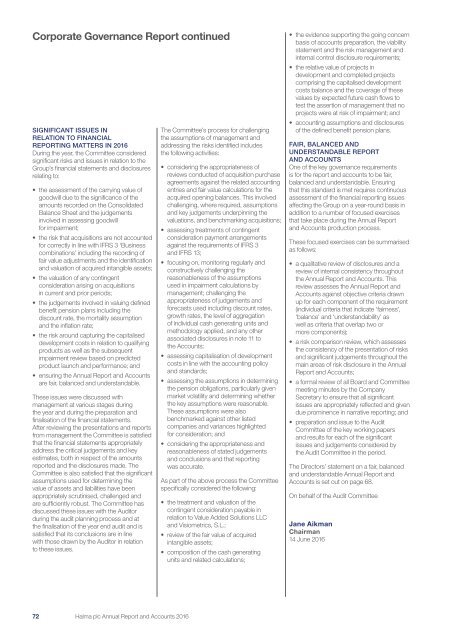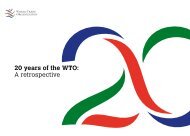You also want an ePaper? Increase the reach of your titles
YUMPU automatically turns print PDFs into web optimized ePapers that Google loves.
Corporate Governance Report continued<br />
SIGNIFICANT ISSUES IN<br />
RELATION TO FINANCIAL<br />
REPORTING MATTERS IN <strong>2016</strong><br />
During the year, the Committee considered<br />
significant risks and issues in relation to the<br />
Group’s financial statements and disclosures<br />
relating to:<br />
• the assessment of the carrying value of<br />
goodwill due to the significance of the<br />
amounts recorded on the Consolidated<br />
Balance Sheet and the judgements<br />
involved in assessing goodwill<br />
for impairment;<br />
• the risk that acquisitions are not accounted<br />
for correctly in line with IFRS 3 ‘Business<br />
combinations’ including the recording of<br />
fair value adjustments and the identification<br />
and valuation of acquired intangible assets;<br />
• the valuation of any contingent<br />
consideration arising on acquisitions<br />
in current and prior periods;<br />
• the judgements involved in valuing defined<br />
benefit pension plans including the<br />
discount rate, the mortality assumption<br />
and the inflation rate;<br />
• the risk around capturing the capitalised<br />
development costs in relation to qualifying<br />
products as well as the subsequent<br />
impairment review based on predicted<br />
product launch and performance; and<br />
• ensuring the Annual Report and Accounts<br />
are fair, balanced and understandable.<br />
These issues were discussed with<br />
management at various stages during<br />
the year and during the preparation and<br />
finalisation of the financial statements.<br />
After reviewing the presentations and reports<br />
from management the Committee is satisfied<br />
that the financial statements appropriately<br />
address the critical judgements and key<br />
estimates, both in respect of the amounts<br />
reported and the disclosures made. The<br />
Committee is also satisfied that the significant<br />
assumptions used for determining the<br />
value of assets and liabilities have been<br />
appropriately scrutinised, challenged and<br />
are sufficiently robust. The Committee has<br />
discussed these issues with the Auditor<br />
during the audit planning process and at<br />
the finalisation of the year end audit and is<br />
satisfied that its conclusions are in line<br />
with those drawn by the Auditor in relation<br />
to these issues.<br />
The Committee’s process for challenging<br />
the assumptions of management and<br />
addressing the risks identified includes<br />
the following activities:<br />
• considering the appropriateness of<br />
reviews conducted of acquisition purchase<br />
agreements against the related accounting<br />
entries and fair value calculations for the<br />
acquired opening balances. This involved<br />
challenging, where required, assumptions<br />
and key judgements underpinning the<br />
valuations, and benchmarking acquisitions;<br />
• assessing treatments of contingent<br />
consideration payment arrangements<br />
against the requirements of IFRS 3<br />
and IFRS 13;<br />
• focusing on, monitoring regularly and<br />
constructively challenging the<br />
reasonableness of the assumptions<br />
used in impairment calculations by<br />
management; challenging the<br />
appropriateness of judgements and<br />
forecasts used including discount rates,<br />
growth rates, the level of aggregation<br />
of individual cash generating units and<br />
methodology applied, and any other<br />
associated disclosures in note 11 to<br />
the Accounts;<br />
• assessing capitalisation of development<br />
costs in line with the accounting policy<br />
and standards;<br />
• assessing the assumptions in determining<br />
the pension obligations, particularly given<br />
market volatility and determining whether<br />
the key assumptions were reasonable.<br />
These assumptions were also<br />
benchmarked against other listed<br />
companies and variances highlighted<br />
for consideration; and<br />
• considering the appropriateness and<br />
reasonableness of stated judgements<br />
and conclusions and that reporting<br />
was accurate.<br />
As part of the above process the Committee<br />
specifically considered the following:<br />
• the treatment and valuation of the<br />
contingent consideration payable in<br />
relation to Value Added Solutions LLC<br />
and Visiometrics, S.L.;<br />
• review of the fair value of acquired<br />
intangible assets;<br />
• composition of the cash generating<br />
units and related calculations;<br />
• the evidence supporting the going concern<br />
basis of accounts preparation, the viability<br />
statement and the risk management and<br />
internal control disclosure requirements;<br />
• the relative value of projects in<br />
development and completed projects<br />
comprising the capitalised development<br />
costs balance and the coverage of these<br />
values by expected future cash flows to<br />
test the assertion of management that no<br />
projects were at risk of impairment; and<br />
• accounting assumptions and disclosures<br />
of the defined benefit pension plans.<br />
FAIR, BALANCED AND<br />
UNDERSTANDABLE REPORT<br />
AND ACCOUNTS<br />
One of the key governance requirements<br />
is for the report and accounts to be fair,<br />
balanced and understandable. Ensuring<br />
that this standard is met requires continuous<br />
assessment of the financial reporting issues<br />
affecting the Group on a year-round basis in<br />
addition to a number of focused exercises<br />
that take place during the Annual Report<br />
and Accounts production process.<br />
These focused exercises can be summarised<br />
as follows:<br />
• a qualitative review of disclosures and a<br />
review of internal consistency throughout<br />
the Annual Report and Accounts. This<br />
review assesses the Annual Report and<br />
Accounts against objective criteria drawn<br />
up for each component of the requirement<br />
(individual criteria that indicate ‘fairness’,<br />
‘balance’ and ‘understandability’ as<br />
well as criteria that overlap two or<br />
more components);<br />
• a risk comparison review, which assesses<br />
the consistency of the presentation of risks<br />
and significant judgements throughout the<br />
main areas of risk disclosure in the Annual<br />
Report and Accounts;<br />
• a formal review of all Board and Committee<br />
meeting minutes by the Company<br />
Secretary to ensure that all significant<br />
issues are appropriately reflected and given<br />
due prominence in narrative reporting; and<br />
• preparation and issue to the Audit<br />
Committee of the key working papers<br />
and results for each of the significant<br />
issues and judgements considered by<br />
the Audit Committee in the period.<br />
The Directors’ statement on a fair, balanced<br />
and understandable Annual Report and<br />
Accounts is set out on page 68.<br />
On behalf of the Audit Committee<br />
Jane Aikman<br />
Chairman<br />
14 June <strong>2016</strong><br />
72 <strong>Halma</strong> plc Annual Report and Accounts <strong>2016</strong>

















